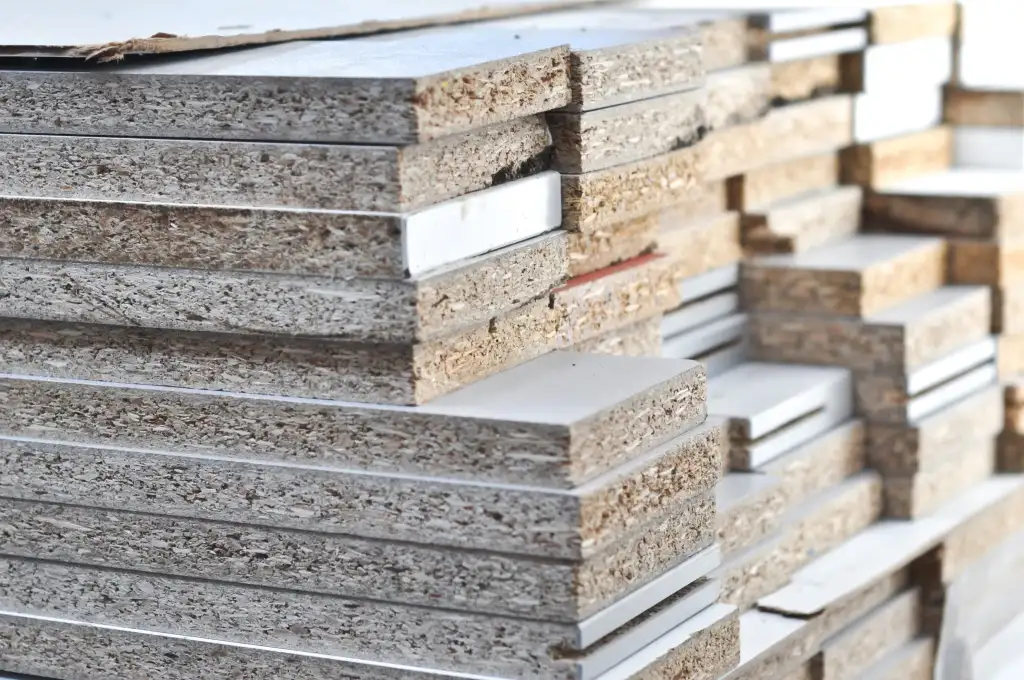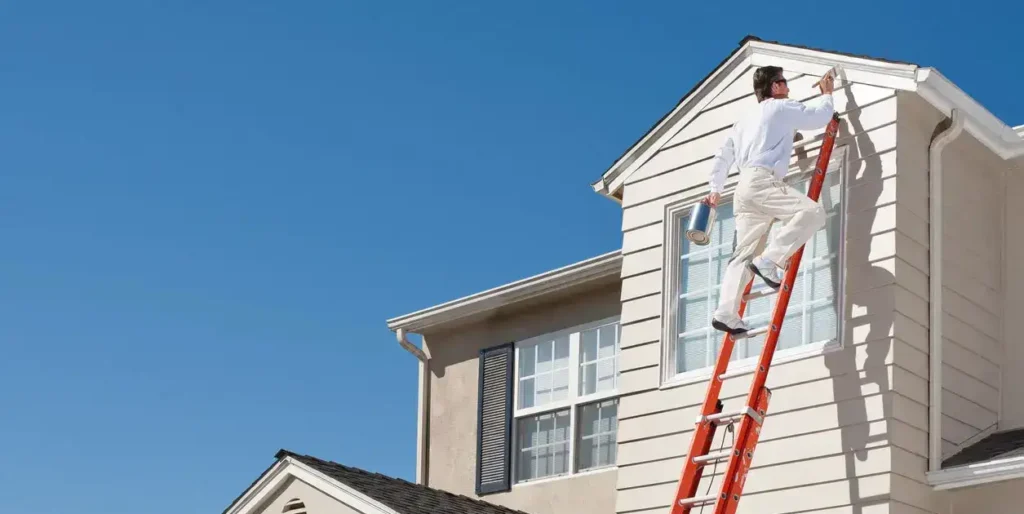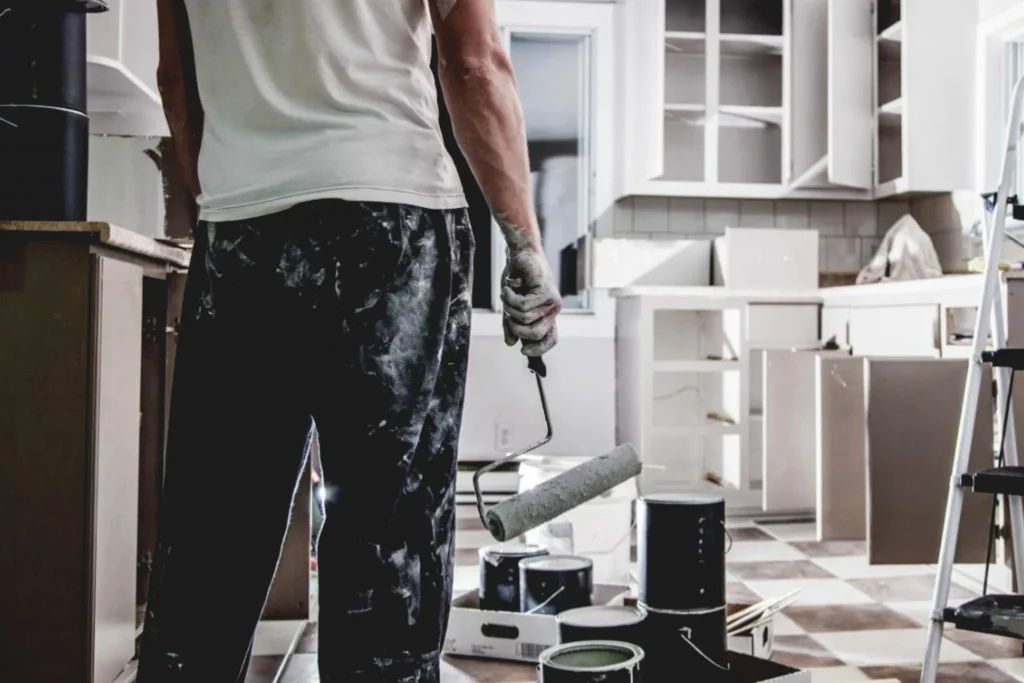Particle board is an engineered wood made from compressed wood particles, resins, and adhesives. It is often used in furniture and construction projects. Although affordable and lightweight, particle board can be prone to moisture and damage, so it is essential to paint it properly for protection.
Have you ever wondered how to transform plain particle board into something sleek and durable? A fresh coat of paint can make all the difference. With the proper technique, your particle board surfaces can look stunning and last longer.
You’ll need simple supplies like primer, paint, and a paintbrush or roller to paint a particle board. Prepare the surface, then apply a primer to help the paint stick. Finally, finish with a high-quality paint for a smooth, durable finish that resists wear and tear.
What is particle board?

Particle board is produced using wood waste materials composed of chips or slices that synthetic resins bind together. The engineered material is known by various names, including chipboard and low-density fiberboard (LDF). The particle board manufacturing process combines multiple elements into one stable product, which differs from natural wood construction.
The cost-effectiveness of particle board surpasses solid wood, MDF, and plywood prices, but its density and layer combination units may differ. Particle board is mainly used in furniture applications when decorating the surfaces of products with melamine or laminate. The material is vulnerable to high moisture conditions, and excessive humidity can cause it to sustain permanent damage. Thus, proper treatment is essential for its preservation.
Why Should You Paint Particle Board?
Painting particle board surfaces has many advantages. Paint makes the surface more visually appealing and shields the board from moisture, dirt, and wear damage. When exposed to direct water, particle boards expand, shift their shape, or become destroyed. Thus, you must apply paint to extend the longevity of your particle board furniture and accessories.
Preparations Before Painting Particle Board
Successful particle board painting depends on the execution of proper planning strategies. Adequate pacing of your work enables durable surface protection, which improves the appearance and durability of your furniture or fixtures. Avoiding rushed procedures when working on the project ensures optimal results. The first step includes obtaining the necessary supplies and reviewing manufacturer instructions to follow an effective process for painting particle boards.
Tools & Supplies for Painting Particle Board
Begin your painting work only after securing every necessary tool and supply. The purchase of essential tools and supplies ahead of time will cut down the process time and workload. The following list consists of items needed for the project:
- Oil-based Primer: You must apply an excellent oil-based primer to lock the paint onto a porous particle board so it sticks appropriately and dries evenly. A primer treatment will also protect the surface from water damage, which could lead to swelling.
- Disposable Dust Mask: Using a disposable dust mask becomes necessary because particle board dust and paint fumes could harm your health. A disposable dust mask protects you against inhaling dust from sanding and protects your lungs from paint fumes while you paint.
- 120-grit Sandpaper: To smooth the particle board surface before applying primer and paint, you need 120-grit sandpaper. This type of sandpaper works perfectly for surface roughening without causing damage.
- Oil-Based Paint for Topcoat: Choose a high-quality oil-based paint for the topcoat. This material creates a resilient, glossy surface capable of resisting regular damage. Oil-based paints provide maximum coverage on particle boards, thus delivering long-term results.
- The 4-inch paint roller kit allows fast, smooth painting across large, flat surfaces without defects. This tool enables uniform paint distribution, which is especially important for broad areas found on shelves, tables, or wall panels.
- Stainable wood filler fills the particle board’s dents, cracks, and holes. This method smooths the surface and prepares it for excellent painting results.
- A one-and-a-half-inch Putty Knife is valuable in distributing wood filler across damages and flattening it for final smoothing. The wood filler enables proper surface coverage by filling in defects of particle board until it achieves a perfect condition before painting.
Having all these tools and supplies ready before you start will make the entire painting process smoother and more efficient. Take your time with each step to achieve the best possible finish.
Get your Particle Board Ready Before Painting
It looks like you’re preparing to restore and paint the particle board. Here’s a quick recap of your process:
- Fixing Damage: Wood putty and a putty knife can mend cracks and dents on the surface. The surface must be dried before being sanded to achieve a uniform texture.
- Repairing Swollen Areas: Apply particle board glue into the swollen area between the particle board pieces with a putty knife before pressing them together. You should clamp the area while the glue dries to fix the vulnerable section.
Start your repairs to allow a proper finish before sanding and priming the surface. This process will restore the particle board’s appearance while providing a clean, fresh finish.
Steps on How to Paint Particle Board
Painting particle board can give it a fresh appearance, but proper preparation is essential because it is highly absorbent. This guide shows all the necessary steps for painting particle boards.
Step 1: Sanding the Particle Board
To begin, particle board requires sanding as the first action. You should let wood fillers and putty dry entirely before using sandpaper to smooth the surface. The surface of the plain particle board contains rough areas with raised fibers that need to be smoothed by sanding.
A sanding pad combined with 120-grit sandpaper provides the best tools for the job. Before sanding the board, use sandpaper to wrap it around a suitable sanding block. The surface will become more leveled by following this procedure—the process of sanding demands utilizing a mask so you can protect yourself from inhaling dust.
The glossy surface becomes slightly roughened through sanding methods. The better board adhesion of primer depends on this step.
Step 2: Apply Oil-Based Primer Coating on the Surface
Decorative particle boards, such as melamine, veneered, and laminated versions, are used in furniture production. Their surface is resistant to numerous paint coatings. The primer application provides an ideal connection between the surface paint and the particle board material.
Paint absorption occurs in particle boards without primer, leading to an uneven paint finish. Sealing the surface with primer allows for the application of a less costly topcoat.
Water-based primers should be avoided on particle boards since they lack adhesion. What works best for priming oil-based products is that users should use proper ventilation and protective devices because these chemicals create potent fumes. Follow these instructions to apply primer on particle board surfaces:
- Clean the surface: Wipe away the sanding dust with a damp cloth before applying primer.
- Allow drying time: Let the primer dry completely.
- Use the right tools. A roller provides a smoother finish but can be challenging to clean with oil-based paint. Brushes are fine, too, but rollers are often preferred.
- Extra layer if needed: Plain particle boards may need an extra primer layer to cover fibers.
- Lightly sand if necessary: If the primed surface feels rough, lightly sand it before applying the final coat.
Step 3: Apply Your Favorite Water-Based or Oil-Based Paint
The next step after primer dryness involves applying paint onto the particle board. You should select between a wide brush roller or sprayer to achieve an even coat. An initial coat must dry in direct sunlight for two hours before applying the final coat of paint. Additional paint applications beyond two coats commonly cover the primer entirely and create a smooth surface that receives adequate coating.
Oil-based paint is suggested for particle board because of its long-term durability, yet water-based paint can be applied successfully after primer. A proper base enables water-based paint finishes to work after primer application, reducing potential problems.
Most people choose furniture finishes that deliver a glossy appearance because they are easy to maintain. However, there are two alternative finishes: matte and chalk paint. You can freely explore decorative effects that will add your personal touch to the final surface appearance.
Step 4: Apply either oil-based or water-based paint in your desired color and finish.
According to primer manufacturers, sanding is unnecessary before applying the last coat. This statement may be valid in specific situations, but individual projects exhibit unique circumstances. When the touch reveals sanding roughness, use 120-grit sandpaper to gently smooth uneven surfaces on the primed area.
Oil-based paint should be used for particle board surfaces, just like primers. Such paint provides excellent durability and a high-quality, smooth surface appearance. The current primer generation is compatible with Coconut- and water-based finishing layers. If proper primer application is followed, water-based paint should not cause problems.
In addition to the standard gloss finish, furniture can be finished with matte paint, chalk paint, or decorative effects for an individual and distinctive appearance.
Step 5: Paint the Particle Board
- Find either high-quality latex or acrylic paint that matches your selected color.
- A paintbrush or foam roller applies the base paint layer in the first step. A thin brush technique helps prevent dripping paint from forming.
- A drying time of 2-4 hours is necessary for the initial coat.
- You should use an extra layer of paint to achieve superior coverage and a smooth final appearance.
Tips for Painting Particle Board
- Select the Correct Paint: Latex or acrylic paint is best on particle boards. Oil-based paint should not be used unless you have already used an oil-based primer.
- Use Thin Coats: Thick paint appears uneven and dries an eternity. Thin coats yield a glossier finish.
- Have Patience: Let the primer, paint, and sealant dry thoroughly before applying the next coat.
- Ventilate Your Environment: Paints and primers can produce strong fumes, so they should be applied in well-ventilated places or outside.
Conclusion
The first step in painting a particle board is sanding its surface to eliminate irregular areas. A high-quality oil-based primer should then help the paint adhere properly. If the primer dries, you should sand lightly once more to guarantee a flat finish.
Begin by applying your choice of paint, whether oil-based or water-based, using thin, level coats. Wait for total dryness between each paint layer application. To personalize your work, select a final coating appearance that matches your taste, such as gloss, matte, or chalk.
FAQS
1. Do I need to sand particle boards before painting?
Sanding is highly recommended because it helps the primer and paint adhere well. Omitting this step will result in a less durable finish.
2. What kind of primer do I use?
Oil-based or shellac-based primers are ideal for particle boards since they seal the surface, thus preventing the paint from soaking in.
3. How many coats of paint do I apply?
Two coats of paint should suffice for a smooth, even finish, but depending on the color of the particle board and the thinness of the paint, you could use a third coat.
4. Can I use spray paint on particle board?
Yes, you can, and it works on particle boards, too. However, to get the best results, you must sand and prime it first.


